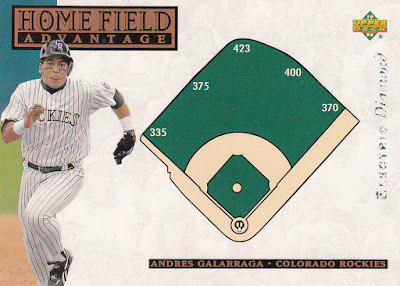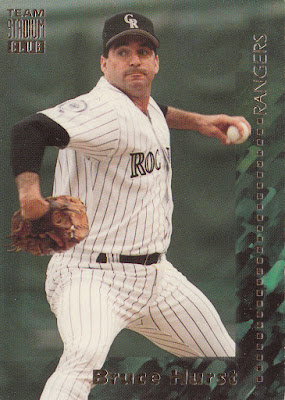 |
| 1999 Pacific Omega #157 Robin Ventura |
In short, this is definitely a Pacific card.
What it's not is a Rockies card. There were White Sox in my two previous posts covering a shipment from Big Shep's Cards, and I chalked it up to the similar uniforms worn by the Rockies and White Sox. I don't have an explanation for why Robin Ventura as a Met ended up in this package, other than that he began his career with the White Sox. Famously so, in fact, as he was with Chicago when that infamous brawl with Nolan Ryan took place.
 |
| 2002 Upper Deck Victory #93 Jeff Cirillo |
Upper Deck noted this transaction in the 2002 release of their no-frills Victory set, a 660-card beast unencumbered by things like relics, autographs, and even insert sets. The photography isn't quite as good, but the set kept the spirit of Collector's Choice alive for a few more years beyond 1999.
The card back clearly lists Cirillo as a Mariner, and mentions his 11-game hitting streak as a Rockie toward the end of the 2001 season, a post-9/11 homestand during which I saw two games. We all had other things on our mind at that time, and I hadn't given much thought to Jeff Cirillo's hitting streak. In the September 29th game, the penultimate home game of the year and a classic 14-12 pre-humidor Coors Field slugfest, I recall Denny Neagle hitting a grand slam, and my sister dropping her Dippin' Dots spoon down to the level below us.
The card back mentions that Cirillo had a trio of three-hit games during that stretch. That was one of them. The game I saw a few days prior on September 26th was another, which was one of Tony Gwynn's final games.
 |
| 1993 Donruss #790 Jerald Clark |
1993 Topps didn't do much with official team logos, except for the back of the Rockies and Marlins dual-player prospect cards. There's a tiny team logo in the upper right, which is a weird mash-up of the longer motion lines but the old color scheme. Have a look:
 |
| 1993 Topps #537 Jason Hutchins (RC) / Ryan Turner (Reverse) |
Getting back to Jerald Clark, sharing the outfield with an all-time great like Gwynn must have been a fantastic experience. Clark never got to go to an All-Star game, although his team hosted the Midsummer Classic in 1992, documented by a large home plate-themed patch on his left sleeve. Flip the card over and you'll get an even better look at it.
That game was held at what was then known as Jack Murphy Stadium, the home of the Padres from their inception in 1969 until the beautiful Petco Park opened until 2004, just the fourth Major League stadium I've had a chance to visit. During the tech boom of the late 1990s, The Murph, as it's still locally known, was renamed Qualcomm Stadium, and remained the home of the San Diego Chargers until they moved northward to Los Angeles in 2017. Qualcomm Stadium was also the place where the Broncos finally won a Super Bowl, XXXII in early 1998. It remains standing, and is the home of the SDSU Aztecs, who once played a basketball game atop the deck of the USS Midway.
 |
| 1994 Score #197 Danny Sheaffer |
Velasquez played part of two seasons with the Padres, mainly off the bench. He appeared in relatively few games, allowing me to pinpoint this photo with complete confidence. It happened on August 8th, 1993 in the bottom of the 4th. Velasquez walked with two outs, advanced to second on a Mo Sanford balk, then was thrown out at home while testing the arm of Dante Bichette, who cleanly fielded a hit by Archi Cianfrocco and fired the ball back in to Sheaffer. That series of events allowed Score to snap a great action shot for the 1994 set, and gave Danny Sheaffer his Infield Fly Rule debut.
This is the first three-part post to appear in The Trading Post theme, and it's covered all the major brands that operated in the baseball card world during the Rockies' existence. Score isn't the most stellar representative of Pinnacle Brands, but it certainly counts and gave us better sets than a lot of people give them credit for.
 |
| 1998 Score Rookie/Traded #RT78 Vinny Castilla |
This Vinny Castilla card looks a lot like a normal 1998 Score card, but the inverted blacks and grays (just like the old Rockies logo!) signify this is actually from the 1998 Rookie/Traded set, even though Castilla was neither a rookie nor traded. The card back has the lengthy write-up typical of Score, which mentions how well he hit lefties in 1997, and the statistics offered a very early hint at the Sabermetrics movement, including columns for Total Bases, On Base Percentage, and Slugging Percentage. They were still in the realm of traditional statistics, but were at least digging a little more deeply than just the usual stats found on baseball cards for decades.
This card would fit well into many mini-collections, thanks to Castilla being shown signing autographs. Even under magnification, I can't tell what set he is signing, but if I had to venture a guess, I think it's one of those perforated sheets of kid-oriented police safety cards. You know, the oddballs that have a color photo on one side and things like "Don't Do Drugs" and "Never Swim Alone" on the back, that sort of thing. I'm pretty sure I had a set like that when I was a kid, but it's likely one of the few parts of my collection that hasn't survived the years.
Not that I am spending a lot of time swimming with no lifeguard on duty anyway, no siree, not me.
 |
| 1997 Collector's Choice Teams #CR Colorado Rockies Logo CL |
Part of this stack included a large quantity of 1997 Collector's Choice. I see that set in trade packages often. However, flipping these over greeted me with some unusual card numbers. "CR 2", "CR 10", and so on. Clearly, they were from a team set, and this shiny card with a fully-fledged Rockies logo on the front is actually the team checklist. Not counting this one, there are thirteen cards, and it includes all the big Blake Street Bomber names of the day. Larry Walker, Vinny Castilla, Dante Bichette, and more. The card says that the 1996 Rockies were the first-ever team with both 200 home runs and 200 stolen bases, as well as a mention of the game in which they put up an 11-spot on July 12th against the Padres.
I have a vague recollection of that game. I wasn't there, but I remember watching a couple wild ones before going away to Boy Scout camp for a week that summer.
 |
| 2004 Upper Deck Power Up #74 Preston Wilson |
So when Upper Deck comes along and comically enlarges a player's head on a photograph, the results are downright terrifying. This card looks like a genetic lab experiment gone wrong. right down to the radioactive green sludge on the background. There's also a 9-character code on the right side, presumably for some type of online game. Confusingly, I happen to have another copy of this card in my collection already, and the code is exactly the same, so I have no idea what's going on here.
Preston Wilson did have quite a few RBI by the 2003 All-Star break, if you can read the strange font, that is. At least there's a shiny area.
 |
| 1999 SP Top Prospects #103 Ben Petrick |
Remember that time Andrew McCutchen's paystub was leaked? Here's the Minor League equivalent.
Anyway, as far as this card goes, it's a sturdy, black-and-gold beauty from SP Top Prospects, showing Ben Petrick as a member of the New Haven Ravens, once a Rockies Double-A affiliate. They have since moved to become the New Hampshire Fisher Cats. Flip the card over and you'll see that Petrick began his Single-A career with Salem, then known as the Avalanche. They're still in Salem, now called the Salem Red Sox.
Maybe Petrick was just that good of a prospect before he ran into health issues, but it seems like I have more minor league cards of Petrick than anyone.
 |
| 1995 SP Silver #15 Juan Acevedo |
As a bonus, the card back has a photo of him bunting! It's another mini-collection hit!
 |
| 1994 Upper Deck #270 Andres Galarraga HFA |
What we're seeing is the Home Field Advantage subset from 1994 Upper Deck, featuring Andres Galarraga. This subset wrapped up Series 1 with National League teams, and continued in Series 2 with the American League teams. On the back, there are plenty of fun facts about the stadium, including the obvious difference between the left- and right-field distances down the line, the fact that fly balls travel farther, and even a brief mention of Coors Field.
We're told that at the time, the Rockies were one of eight teams to share a home with an NFL team. Now, following the conclusion of the Oakland A's season, there are no more shared stadiums across baseball and football, as the Raiders are moving to Las Vegas.
In addition to all that, there are also home and road splits for both Galarraga and the Rockies as a whole. They crammed a lot in on the back, partially because the front is pretty sparse. Go find the base card and you won't even see that sparkly Electric Diamond text.
 |
| 2001 Upper Deck MVP #323 Ron Gant |
This is a double-debut post, as Ron Gant is joining Danny Sheaffer as members of the Infield Fly Rule club. I definitely remember Sheaffer, but Ron Gant as a Rockie is a lot fuzzier in my mind. He played here for less than sixty games in 2001. I remember him much more clearly as a Brave.
Upper Deck made a prediction on this card, expecting him to reach the 300-homer mark in 2001. When the Rockies traded him in July, he had precisely 300 home runs, adding two more on with Oakland to close the season. His career ended two years later, finishing up with 321, just two less than this card number.
I'm sure he wasn't chasing his card number.
If you celebrate it, enjoy your Hanukkah, which begins tonight. Otherwise, have a great Christmas or any other holiday you choose. Thanks for reading!














